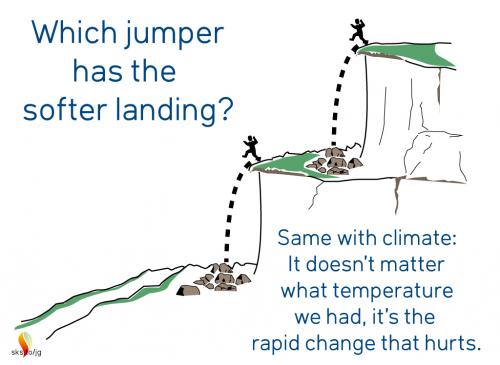
Regardless the height of the cliff, jumping from cliffs is deadly.
Regardless of the height of a cliff, jumping from cliffs is deadly. Hang-gliding from cliffs thrills. Jumping from cliffs kills. Jumping 10 m from a cliff that is 1000 m above sea level hurts just as much as jumping 10 m from a cliff that is 900 m above sea level.
Increasing or decreasing the global average temperature causes sea level to rise or fall. Rapidly increasing or decreasing the global average temperature will likely cause sea level to rapidly rise or fall. It does not matter what the current global average temperature is. Causing the global average temperature to jump, as we are, causes sea level to jump. A snail can outrun sea level change, but houses, sky scrapers, buildings, subways, and roads move slower than snails. They sit where they are and drown. Are your children and grand children prepared for this coming future? Is there anything we can do to slow down the ongoing global temperature jump?

The motivation for this analogy is to explain why the science community focuses on "temperature anomalies" (i.e., temperature changes) instead of absolute temperatures. It does not matter what the Earth's temperature was before the start of the industrial revolution. It is the temperature change since then that is causing problems. The Paris Accord strives to limit global warming to no more than 2°C above pre-industrial levels, and does not specify a specific, absolute global average temperature that we need to stay below.1
If we were doing something to cool the Earth it would also be harmful, because cooling the Earth would cause sea level to fall, and likely would also shift precipitation patterns, agricultural zones, etc. It is not the absolute average temperature of Earth that matters. What matters is that we've spent about 7000 years settling 8 billion people around the Earth in just about every habitable nook and cranny with the climate to which we've become accustomed. Changing that climate by changing the temperature will have consequences.
1. Read here for more information about how and why 2°C became adopted as the upper limit of warming acceptable in agreements designed to limit warming.
Posted by Evan on Wednesday, 30 January, 2019
 |
The Skeptical Science website by Skeptical Science is licensed under a Creative Commons Attribution 3.0 Unported License. |